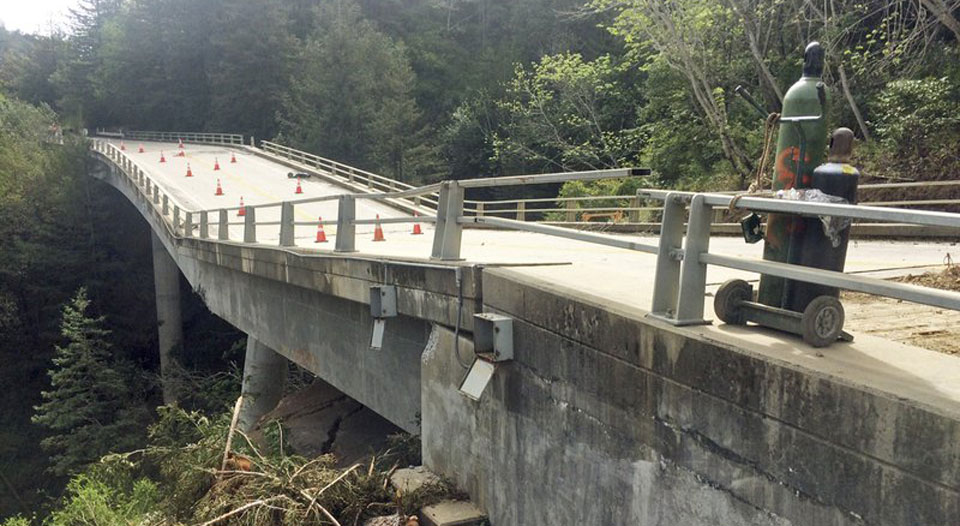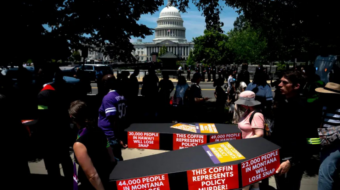
WASHINGTON—The U.S. needs $2 trillion to bring its crumbling roads, creaky railroads, aging airports, 100-year-old water pipes, and crowded subways up to snuff. It needs $2.5 trillion more to get ahead of the game and build projects to handle people, business, and growth in the 21st century, studies calculate.
But whether it will get the cash, much of it from the federal government, and spend it, is largely up to one man: President Donald Trump.
If he says “yes” to raising money for construction, legislation to rebuild U.S. infrastructure will quickly go through Congress, with Democratic, Republican, labor, and business support, speakers at a May 13 conference declared.
If he doesn’t, it doesn’t go through at all.
That was the conclusion, both implicitly and explicitly, of many speakers at the half-day confab to kick off the seventh annual National Infrastructure Week. The week will see more than 100 events elsewhere nationwide and lobbying by unions, businesses, and state and county officials on Capitol Hill. A 52-group coalition, including the AFL-CIO and building trades unions, is sponsoring it.
“We need a major infusion by the federal government to do a massive infrastructure rebuild and build out,” which would also produce tens of thousands of well-paying construction jobs, said Sean McGarvey, the president of North America’s Building Trades Unions, and one of three union speakers at the D.C. event.
And those jobs, which, once young people complete apprenticeships—without heavy college debt and with just a high school diploma along with the specialized training building trades provide—would pay each of them $60,000-$80,000, added McGarvey.
“If we can do a massive infrastructure bill…we’ll lift hundreds of thousands of people,” he stated.
“Infrastructure is an amazing virtuous circle where you’re creating jobs and making things people need”—roads, bridges, airports, subways. “So why are we not actually getting it done?” Teachers President Randi Weingarten asked rhetorically during her panel discussion.
Answering her own question afterwards, she explained: “You need to invest public money for public goods. You can’t have a focus on infrastructure without the investment in it.”
But the “major infusion” of federal funds will come by, for starters, raising the federal gas tax, which has been stuck at 18.4 cents per gallon ever since the Reagan administration. Both unions and businesses back increasing it, though speakers didn’t suggest specific hikes. Also left unsaid: Like a sales tax, the gas tax hits poorer people harder than it hits those with middle incomes and the rich.
The speakers also admitted even raising the gas tax wouldn’t be enough for all the infrastructure repairs and improvements the U.S. needs, but it would be a starting point.
That progress, in turn, would encourage federal officials to find funding sources for other infrastructure development—everything from retrofitting schools to make them energy efficient to rebuilding the U.S. electric grid and replacing those old water pipes.
Several speakers added green sources, such as solar panels, wind farms, and hydropower, to the infrastructure mix, and one, House Majority Leader Steny Hoyer, D-Md., threw in nuclear power.
“They know there are jobs attached,” to new infrastructure projects, McGarvey said.
The alternative sources, except for the controversial nuke plants, are the top emphasis of the Green New Deal, which progressive House Democrats are pushing—and which building trades unions are leery of. Nobody mentioned that plan by name.
There are other jobs affected, too, said Weingarten: Those of teachers, nurses, whom her union represents, and other workers. They get caught in traffic jams on deteriorating roads, another speaker said. And school kids, too, Weingarten added.
And it’s not just old pipes and contaminated water in Flint, Mich., Yonkers, N.Y., Newark, N.J., and elsewhere.
“In Detroit, teachers” get to school early, “wear gloves, bring paper towels and cleaners” and disinfectants “and clean (animal) droppings off the floor” before classes begin. Retrofitting schools would include “making them safe and sanitary,” she said.
That goes for all infrastructure, McGarvey said. During the panel discussion, he said the first criterion for any infrastructure project should be “health and safety of the citizenry.”
“We have water systems that are contaminated and roads and bridges that are dilapidated,” he added. “if you start with” working on “the roads they (people) drive on, the water they drink, and the schools their kids go to, we can do this.”
In general, public opinion polls show overwhelming support for more infrastructure investments, especially in roads, railroads, and subways, in that order, with smaller shares for bike trails and other alternatives. And one speaker noted that last November, voters approved 77% of state and local transportation bond issues.
“Our state and local” building trades “councils are all connected to the same groups” lobbying for federal infrastructure aid, “but at the state level,” McGarvey explained. “And they’ve been a lot more effective.”
But the federal government is another matter. Infrastructure legislation has stalled in Congress for years. Partly it’s due to public mistrust of the feds, partly due to gridlock in D.C., and partly due—speakers at the funding panel said—to lawmakers needing “political cover” to raise the gas tax.

So far, despite a big meeting between Trump and congressional Democratic leaders two weeks ago on infrastructure, that cover isn’t there, speakers pointed out. Trump has waffled on a funding source—he prefers private enterprise shoulder the burden—and McGarvey said in a brief comment afterwards the president’s response is due in two weeks.
“The Democrats are ready, the House is ready. The president must be ready,” to fund infrastructure, Hoyer, the keynote and closing speaker, bluntly said.
But how? Those same polls, including one released the day of the conference, show 45% support for raising the gas tax and 55% for charging users only, via tolls and similar levies.
There was another obstacle at the Trump-hosted meeting, said Hoyer: Top Republicans, except for Transportation Secretary Elaine Chao, weren’t in the room. Hoyer cited one absentee: Trump Management and Budget Director Mick Mulvaney, who steadfastly and publicly opposes a gas tax hike.
Also absent, though Hoyer didn’t say so, was another gas tax hike foe, Senate Majority Leader Mitch McConnell, R-Kent., Chao’s husband. McConnell bluntly said on May 6 he’ll quash any tax hike, in the gas tax or anywhere else, in this Congress.
Trump himself has talked about having state and local governments, plus private firms, spend 70% or more of U.S. infrastructure money for national projects, not just local roads and bridges.
Other speakers at the conference, including state and local officials, said that’s not financially doable. One noted the feds funded 90% of the last planned nationwide major infrastructure system: The interstate highways, which started in 1958.
Hoyer ended by telling conference participants they have to go out and lobby their members to put pressure on lawmakers to build infrastructure—and to raise the money to do so.
“I told the president: ‘There’s not a member of the House or a member of the Senate who will stick their neck out” for higher taxes for infrastructure, “unless you’re leading it.’” Trump did not comment.
“If the president does not lead, it will not happen. It’s as simple as that.”










